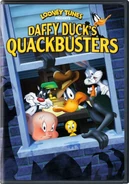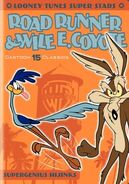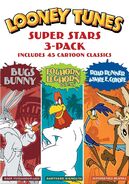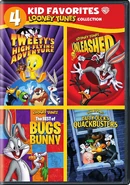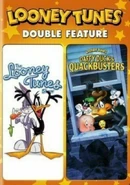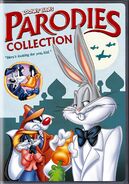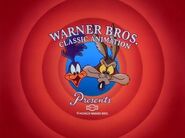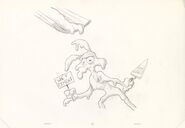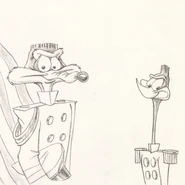Little Go Beep is a 2000 Looney Tunes short directed by Spike Brandt.
Title[]
The title is a play on "Little Bo Peep".
Plot[]
Baby Wile E. Coyote is told by his father, Cage E. Coyote, that he is not allowed to talk until he catches a roadrunner. Wile E. sees Baby Road Runner. As the roadrunner is running, the action freezes and words pop up saying: Road Runner (Morselus babyfatius tastius), which reveals that the roadrunner is running with the aid of a babywalker. The action freezes again and says: Coyote (Poor schnookius) and the coyote falls on the words that popped up.
- Wile E. uses some keys to open a door to a room that has dangerous explosive items and is blown up.
- Wile E. uses a badger trap to try to catch the roadrunner, but he catches a badger instead.
- Wile E. gets a package in the mail, a stretch hamstring to stop the roadrunner, but is crushed by two cacti.
- Wile E. uses his jack-in-the-box to punch the roadrunner, but he gets punched instead. He does get the roadrunner, but then fails.
- Wile E. uses toy rockets full of water on a big trike but gets in the badger trap and is beaten up by the badger he caught earlier.
Cage is proud that his son tries to catch the roadrunner, but he will not be able to talk for a long time.
Availability[]
(2009) DVD
Daffy Duck's Quackbusters
Daffy Duck's Quackbusters
(2011) DVD
Road Runner
Road Runner
(2013) DVD
Looney Tunes Super Stars 3-Pack, Disc 3
Looney Tunes Super Stars 3-Pack, Disc 3
(2014) DVD
Looney Tunes Super Stars Family Multi-Feature, Disc 3
Looney Tunes Super Stars Family Multi-Feature, Disc 3
(2015) DVD
4 Kid Favorites Looney Tunes Collection
4 Kid Favorites Looney Tunes Collection
(2020) DVD
Looney Tunes: Parodies Collection
Looney Tunes: Parodies Collection
Streaming[]
iTunes (2021 - ) (cropped to 16:9 aspect ratio)
Warner Bros. Discovery RIDE (2021 - 2023) (cropped to 16:9 aspect ratio)
Notes[]
- This is the only appearance of Wile E.'s father, Cage E. Coyote, as well as the only cartoon to reveal his family members.
- One of the photos shown in the opening credits is an homage to the opening title card shot of "Zoom and Bored".
- Two of Cage's trophies were named after Chuck Jones and Michael Maltese, both of whom worked on the original Road Runner cartoons.
- This cartoon explains why Wile E. does not talk. This is confusing because Wile E. did speak in the Bugs Bunny cartoons, Adventures of the Road-Runner, an episode of Tiny Toon Adventures, some webtoons, some books and comic books, and in New Looney Tunes.
- It also explains why Wile E. actually wants to catch Road Runner; however, Wile E. previously explained that he wants to eat Road Runner in "Zip Zip Hooray!"
- In the book held by Cage E. in the paragraph on the bottom, "Geococcyx californianus", the scientific name of the greater roadrunner, is misspelled as "Geococcyx Califoriaus" without any lowercase Ns.
- The baby Road Runner's high-pitched beeping is similar to the shrunken Road Runner's beeping in 1980's "Soup or Sonic", which is achieved by speeding up Paul Julian's "beep beep" stock sound effect in post-production.
- This was Richard Stone's final musical collaboration before his death in 2001.
- This is the final Coyote/Road Runner short produced in fullscreen, as well as the first Looney Tunes cartoon to be produced in digital ink and paint, although the opening and ending titles used cels.[2]
- A widescreen print, which was created by masking the top and bottom sides of the short, was also made.[3]
- This is the last theatrically released Looney Tunes cartoon until "Coyote Falls" in 2010, and thus the last one released in the 20th century and the only one released in the 2000s. Warner Bros. initially planned to theatrically release a series of new Looney Tunes and Tom and Jerry shorts, only to be aborted and have any already-made ones released to home video or television instead upon the box-office bomb of Looney Tunes Back in Action in 2003.
- The ACME Jr. logo in some of Wile E. Coyote's gadgets would later be used as the Nick Jr. logo for preschoolers in 2009.
- This cartoon was previewed in Los Angeles in November 2000 with the movie Best in Show to qualify for an Academy Award for "Best Animated Short".[4]
- According to Earl Kress, of the three instances he saw "Little Go Beep" at the Century City AMC, which previewed the short for the Academy Award nomination, it did not run during the first or third time. The short did not arrive at AMC the first time, and was skipped the third time. He had to call Warner Bros., with Warner Bros. calling AMC to put the short back in.[3]
- The short was part of the top ten shorts for the 73rd Academy Awards, but was not nominated for "Best Animated Short" due to not being part top five, which is needed to be nominated.[3]
- This cartoon was made while Baby Looney Tunes was still in development, and it features the show's logo at the end.[3]
- This short was to be part of a feature-length direct-to-video Baby Looney Tunes anthology film, with a Bugs Bunny and Yosemite Sam short, as well as a Sylvester and Tweety short also being written by Earl Kress, with Gary Hartle and Kirk Tingblad to direct either of those two shorts. It was shelved as a result of Warner Bros. Consumer Products, whom initially approved of a Baby Looney Tunes project, not willing to pay for production.[3]
- On iTunes and Warner Bros. Discovery RIDE, this cartoon was cropped to a 16:9 aspect ratio.
- For unknown reasons, this short is not available on Boomerang or Max.
- Before Stan Freberg was chosen for the role of Cage E. Coyote, many voice actors, including Darryl Kurylo, Jim Ward, Carlos Alazraqui, Mark Hamill, Michael Bell, Alan Oppenheimer, Bill Farmer, Charles Kimbrough, Jeff Bennett, Michael Gough, John O'Hurley, David Ogden Stiers, and Joe Alaskey, all auditioned for the role.[5]
- After the animation was finished, a second set of auditions were held, this time to replace Stan Freberg with Dee Bradley Baker being cast as Cage E. Coyote. Baker thus dubbed Freberg's lines and line deliveries. Freberg's performance was eventually reinstated.[3]
Gallery[]
Opening card with Road Runner and Wile E. Coyote
Color guide for Cage E. Coyote
References[]

